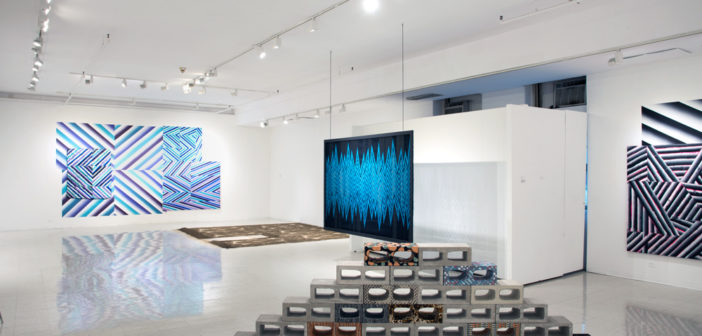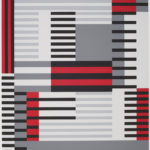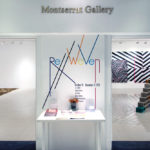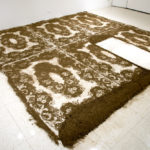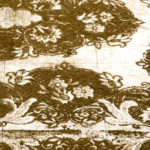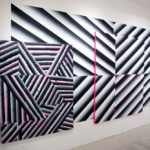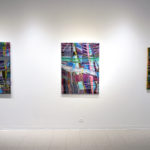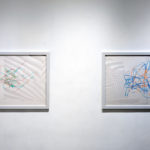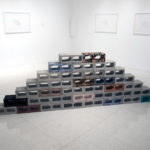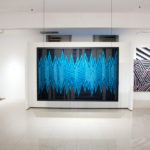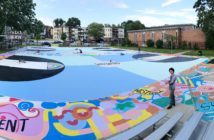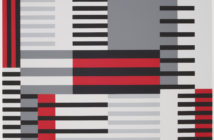In a 1968 interview, Anni Albers described her initial relationship with textiles as a tepid one, at best. When she first arrived at the Bauhaus in 1922, each new student was required to take an introductory hands-on workshop. The classes, however, were either already at capacity or didn’t appeal to the 23-year-old Albers. “The only thing that was open to me was the weaving workshop,” recalled the artist. “And I thought that was rather sissy.” [1]
In time, however, Albers grew to appreciate what she initially perceived to be the confining limitations of weaving. The structure of its process—the weft and the warp—presented a creative challenge to the artist who had heretofore wanted to pursue painting. “I felt that the limitations and the discipline of the craft gave me this kind of...railing. I had to work within a certain possibility, possibly break through.” [2]
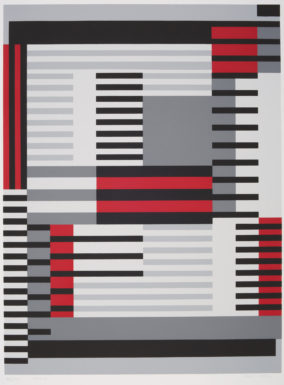
Anni Albers, "Smyrna-knüpfteppich (Bauhaus-period), from the portfolio "Connections/1925/1983", 1925 Screen print, image: 20 1/8 in. x 15 1/8 in. (51.1 cm x 38.4 cm); sheet: 27 1/2 in. x 19 11/16 in. (69.8 cm x 50 cm)
Museum purchase, The Nancy Gray Sherrill, Class of 1954, Collection Acquisition Fund 2016.6.2
Anni Albers: Connections, now on view at the Davis Museum in Wellesley, presents a selection of the "possibilities" Albers envisioned for weaving. The exhibition demonstrates Albers’ innovative approach to the medium and illustrates her role as an early progenitor of the fiber art movement, decades before its emergence in the 1960s and 70s. But it also reveals how she approached weaving—its structure, process, and form—using various non-fiber materials. The exhibition centers around a portfolio of nine silkscreens, titled Connections, that traces her interest in certain patterns and colors while exploring the very nature of the medium itself. In addition to the silkscreens, the show includes her watercolors, pen and pencil sketches on graph paper, and embossed prints. She was even known to make repetitive marks with a typewriter, or punch holes through paper, in order to create studies for potential designs.
Across the city in the suburbs of the North Shore, the Montserrat College of Art in Beverly has staged the exhibition RE//Woven, featuring a group of artists who, similar to Albers’ practice of making silkscreens, address “the aesthetics and gestures of traditional weaving and pattern-making through the use of untraditional mediums.”[3] Each of the six artists incorporates references to textiles in their work, but you will not find towering fiber sculptures, looping coils of rope, or even much fabric material here at all. They carry on the tradition established by Albers—in some cases directly referencing her work—using unexpected materials and unique modes of display to address the history of weaving while re-energizing the medium.
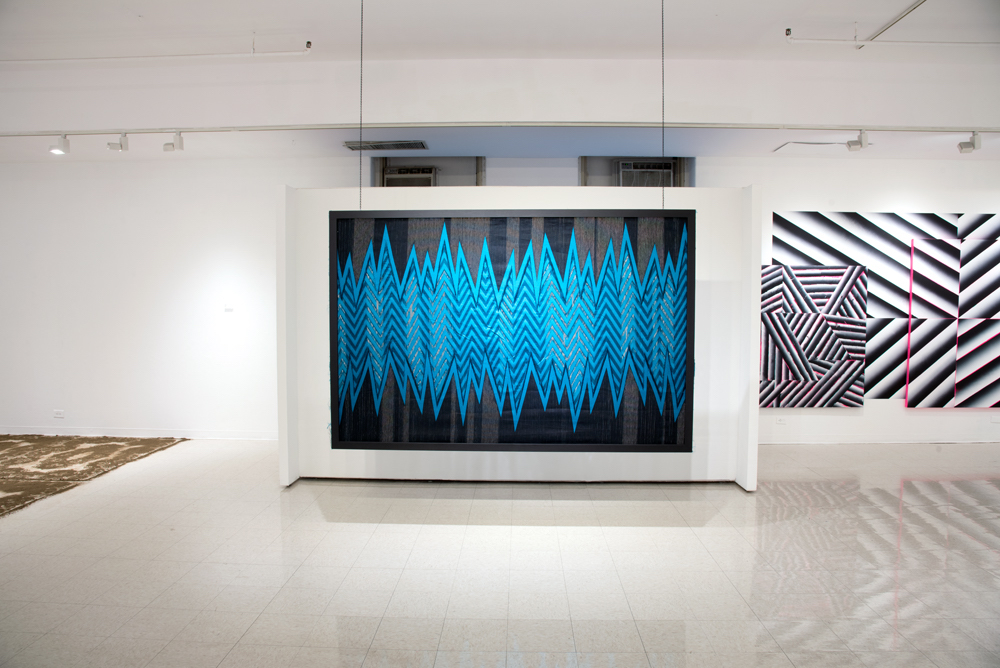
Installation view of "RE//Woven" at the Montserrat College of Art, Beverly, MA. Image courtesy of Nathan Lewis.
At the center of the gallery, Liz Collins’ handwoven tapestry Midnight crackles with energy, its design resembling a graph that measures sound or vibration. The electric blue chevron pattern contrasts sharply with a background of woven black thread, and while some areas of the work are densely woven, others are so thin they are transparent. Stretched in a frame and suspended from the ceiling, the viewer is allowed access to both sides of Midnight—the “finished” face of the work and the raw, textural backside. By displaying the tapestry this way, Collins reveals and celebrates the process inherent in weaving, exposing elements that would traditionally be hidden from sight: selvedges, frayed hems, the inverse of the design. This level of transparency calls into question what we value and choose to put on display in traditional weaving practices, and highlights the distinction between public and private selves.
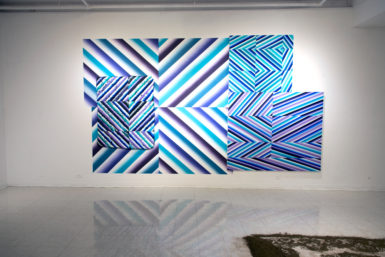
Installation view of "RE//Woven" at the Montserrat College of Art, Beverly, MA. Image courtesy of Nathan Lewis.
Similarly bold and geometric, Nathan Green’s murals blend the cool aesthetic of minimalist abstraction with techniques of craft to “expand painting into three dimensions, to take it off the canvas, to create objects that talk the language of painting.” The New York-based artist applies acrylic paint directly to the gallery wall in bold diagonal lines that gradate from rich purples, blacks, and royal blues to white. Both works recall the immersive wall drawings of Sol Lewitt, but Green breaks up the flat expanse of his murals by inserting multiple painted canvases into the composition, which sometimes disrupt, sometimes continue, the patterns on the wall. The canvases lend depth and texture to an otherwise planar composition. With smaller units comprising the whole, the paintings are composed like a quilt and give the overall effect of a woven textile.
Boston-based artist Maria Molteni’s intimate drawings depict tangles of thread—or, as the titles reveal, discarded nylon strings from tennis rackets. Deceptively simple and candy-hued, the lines transition from neon orange and hot pink to pale greys and blues. This new series is inspired by Anni Albers’ knot drawings (which she often referred to wonderfully as “line involvements”), a selection of which are on view in the Davis show. While some of Albers’ watercolors and sreenprints possess the symmetry of Celtic knots, Molteni’s drawings seem more influenced by the random and meandering lines that appear in works like Untitled, from the portfolio "Connections/1925/1983."

Maria Molteni, “Knot Study”, 2016. Courtesy of Montserrat College Galleries.
Whether finger-knitting colorfully bedazzled basketball nets or weaving the loose, grid-like forms of tennis nets in fluorescent rope, Molteni’s artistic practice cleverly marries the traditionally opposing schools of craft and sport. She continues this tradition here in her Racket String Studies, deconstructing the warp and weft of a tennis racquet to explore the material in its relaxed and unfamiliar state. The careful studies allude to the surprising intersections between the spheres of athletics and textiles while successfully staking out new territories where the two can coexist.
Nearby, Raquel Paiewonsky’s Wall is comprised of a low pyramid of cinder blocks, several of which are wrapped in a casing of decorative cloth. The bright, sometimes gaudy fabrics are hand-embroidered by the artist and soften the rough and austere exterior of the concrete bricks. Incorporating elastic and pliable fabric materials in her work allows Paiewonsky “to deal with political and social subjects that can have an edge and that can be very harsh.”[5]
Paeiwonsky, who lives and works in the Dominican Republic, created her first concrete block piece, Mauer (German for “wall”), in 2015. The sculpture was inspired by the history of the Berlin Wall, a widely recognized symbol of segregation and confinement. Paiewonsky’s Wall, despite its fortress-like appearance, does not form an actual barrier. The piece functions almost as an architectural folly within the gallery; while it’s title suggests an impermeable obstruction, the viewer is able to circle Wall, crossing easily over to the other “side.”

Installation view of "RE//Woven" at the Montserrat College of Art, Beverly, MA. Image courtesy of Nathan Lewis.
Albers once described weaving as a type of architecture in itself, explaining that it “is closest to architecture because it is a building up out of a single element, to building a whole out of single elements.”[6] To illustrate her weaving patterns, she drew on graph paper, indicating everything from simple to complex patterns using squares, rectangles and triangles. Paiewonsky’s cinder block structure resembles Albers’ more basic designs, which stagger rows of “simple geometric elements within a grid” to achieve diagonal lines.[7] While Paiewonsky is interested in the physical structures that define our society, she is also concerned with the intangible structures that determine how we move through the world. Her work is an attempt to access, as the artist explains, “our biological and psychological being, as opposed to what has been socially learned—socially constructed ideas.”[8]
Across the room, Cal Lane’s site-specific installation Dirt floor uses soil to replicate patterns of lace on the gallery floor. To achieve the ornate filigree of this “floor drawing,” the New York-based artist sifted earth through a large piece of lace, the impression of which is transferred to the floor. Even the most delicate areas of netting are successfully translated into tiny threads of dirt, and Lane has repeated the process to create six nearly identical imprints.
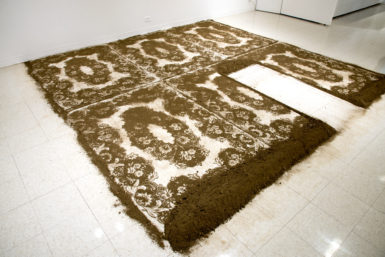
Installation view of "RE//Woven" at the Montserrat College of Art, Beverly, MA. Image courtesy of Nathan Lewis.
The materials Lane used for Dirt floor carry particularly personal symbolic value: the dirt is sourced from her home and studio in Putnam Valley, New York, while the lace is a family heirloom she received from her mother. The unexpected combination juxtaposes synthetic with organic, fragile with rugged, and precious with commonplace, while also referencing physical labor as it relates to lacework, blue collar trades, and artmaking.
Lane describes her work as akin to “a wrestler in a tutu” in that “the absurdity of having opposing extremist stances is there for reaction and not rational understanding; the rational discussion arises in the search for how one thing defines the other by its proximity.”[9] Lace, with all its historical affiliations with purity, femininity and delicacy, is literally soiled here. Yet the soil itself, reimagined as lace, begins to take on similar qualities. Delicate and ephemeral, the slightest puff of air would disturb the piles of dust and mar the pattern. Lane underscores this vulnerability by interrupting the design with the sweep of a push broom, a poignant reminder of its impermanence and fragility.
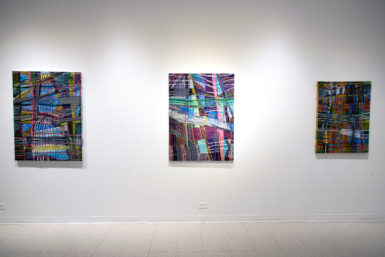
Installation view of "RE//Woven" at the Montserrat College of Art, Beverly, MA. Image courtesy of Nathan Lewis.
Stacey Piwinski, who lives and works in the Boston area, often includes materials as varied as ceramics, found objects, and cyanotypes in her work. Included in the exhibition are three examples from her Objects of Labor series, trompe-l’oeil compositions rendered in vivid hues and earth tones that combine traditions of painting and fiber art. For each work, Piwinski used paint to mimic the forms and patterns of a woven textile. Painted lines thread their way across the canvas vertically and horizontally, weaving in and out of view. She further enhances the illusion by embedding lengths of string and strips of cloth within the layers of paint. As the artist explains, “I paint like a weaver and weave like a painter.”[10] The result is a dense field of texture and color, an abstraction of the vibrant and complex patterns found in Peruvian textiles and West African kente cloth.
In considering the significance of an exhibition like RE//Woven, it’s helpful to think back on the historical movement of fiber as an art form. Despite Albers’ early innovations as a fiber artist, the medium has had to contend to shed the label of “craft” and confirm its place alongside painting, sculpture and other fine art traditions. In 2014, the ICA/Boston presented Fiber: Sculpture 1960-Present, a large-scale survey of contemporary artists whose “work demonstrated a revolutionary redefinition of an ancient material.”[11] On display were monumental, cascading abstractions and intricate installations by artists like Eva Hesse, Faith Wilding, and Sheila Hicks. As Hicks warned: “Watch out, the big guys, like [Richard] Serra...What he can do with Cor-Ten steel, I can do with fiber. That’s why they’re nervous.”[12]
Here in RE//Woven, however, there is no need to compete. The artists do not manipulate textiles in order to make them stack up to other art forms. Instead, their work dismantles any latent hierarchy between genres, using industrial materials and traditional fine art mediums to imitate or give the illusion of fabric in a kind of ode to craft. The works seamlessly blend the history of textiles with painting, sculpture, drawing, and architecture. These artists champion craft while only subtly alluding to its forms, making the argument that fiber art is a tradition worthy of imitation itself while expanding it into another sphere entirely.
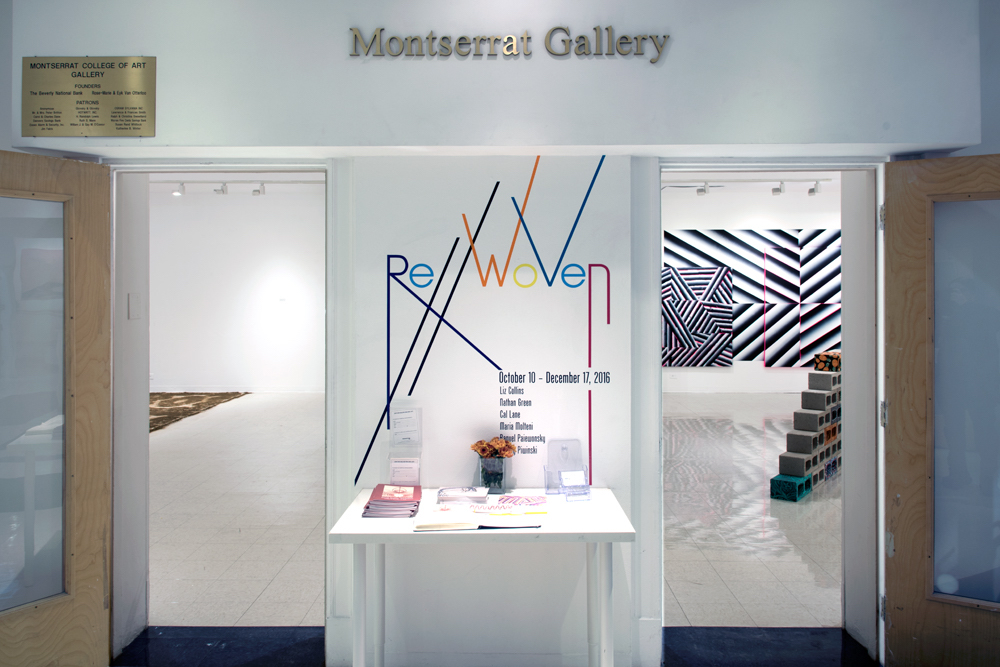
Installation view of "RE//Woven" at the Montserrat College of Art, Beverly, MA. Image courtesy of Nathan Lewis.
- Anni Albers, “Smyrna-knüpfteppich (Bauhaus-period), from the portfolio “Connections/1925/1983”, 1925 Screen print, image: 20 1/8 in. x 15 1/8 in. (51.1 cm x 38.4 cm); sheet: 27 1/2 in. x 19 11/16 in. (69.8 cm x 50 cm) Museum purchase, The Nancy Gray Sherrill, Class of 1954, Collection Acquisition Fund 2016.6.2
- Installation view of “RE//Woven” at the Montserrat College of Art, Beverly, MA. Image courtesy of Nathan Lewis.
- Installation view of “RE//Woven” at the Montserrat College of Art, Beverly, MA. Image courtesy of Nathan Lewis.
- Installation view of “RE//Woven” at the Montserrat College of Art, Beverly, MA. Image courtesy of Nathan Lewis.
- Installation view of “RE//Woven” at the Montserrat College of Art, Beverly, MA. Image courtesy of Nathan Lewis.
- Installation view of “RE//Woven” at the Montserrat College of Art, Beverly, MA. Image courtesy of Nathan Lewis.
- Installation view of “RE//Woven” at the Montserrat College of Art, Beverly, MA. Image courtesy of Nathan Lewis.
- Installation view of “RE//Woven” at the Montserrat College of Art, Beverly, MA. Image courtesy of Nathan Lewis.
- Installation view of “RE//Woven” at the Montserrat College of Art, Beverly, MA. Image courtesy of Nathan Lewis.
- Installation view of “RE//Woven” at the Montserrat College of Art, Beverly, MA. Image courtesy of Nathan Lewis.
- Installation view of “RE//Woven” at the Montserrat College of Art, Beverly, MA. Image courtesy of Nathan Lewis.
- Installation view of “RE//Woven” at the Montserrat College of Art, Beverly, MA. Image courtesy of Nathan Lewis.
- Oral history interview with Anni Albers, 1968 July 5, Archives of American Art, Smithsonian Institution.
- Ibid.
- Press release for RE//Woven, Montserrat College of Art, no date, accessed November 19, 2016. http://www.montserrat.edu/portfolio-item/re-woven/
- Bob Chaundy, "Space Age - Hus Gallery," Huffington Post, November 17, 2014, accessed November 30, 2016. http://www.huffingtonpost.co.uk/bob-chaundy/space-age-hus-gallery_b_5835010.html
- Davidoff Art Initiative, "Davidoff Art Initiative - Raquel Paiewonsky," Online video clip, Vimeo, June 2, 2015, accessed November 28, 2016. https://vimeo.com/129531338
- Oral history interview with Anni Albers.
- Gallery label for Untitled, 1968, pencil on paper, The Josef and Anni Albers Foundation 1994.10.220 at the Davis Museum, Wellesley, MA.
- Davidoff Art Initiative, "Davidoff Art Initiative - Raquel Paiewonsky."
- Kate Sierzputowski, "Blowtorch Filigree: Lace Patterns Delicately Cut from Steel Objects by Cal Lane," Colossal, April 16, 2015, accessed December 1, 2016. http://www.thisiscolossal.com/2015/04/blowtorch-filigree-cal-lane/
- Stacey Piwinski, "Artist Statement," Stacey Piwinski, no date, accessed November 28, 2016. http://www.staceypiwinski.com
- Jenelle Porter, "The Materialists," in Fiber: Sculpture 1960-Present, ed. Jenelle Porter (Munich: DelMonico Books, 2014), 9.
- Sebastian Smee, "ICA displays woven marvels," The Boston Globe, October 2, 2014, accessed November 30, 2016. https://www.bostonglobe.com/arts/theater-art/2014/10/02/the-ica-displays-marvels-woven-with-thread-rope-and-more/bYj5A63e9kDzABcTLNX5qO/amp.html

